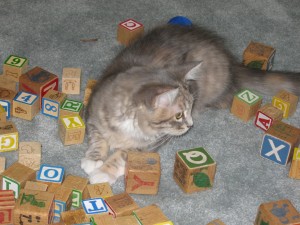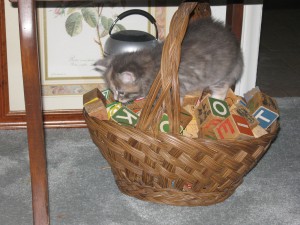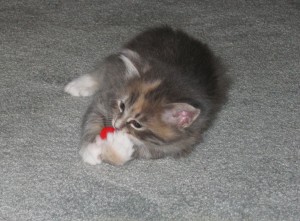 Yesterday we talked about having fun with your cat. You’re probably still going through the 101 things you can do with your cat at that site I suggested. If you didn’t check this out, you should. It’ll give you some great ideas for bonding with your cat. You and Fluffy will benefit in many ways. You know how good laughter is for our health. You can’t interact with a cat without bursting out laughing. And some of the activities listed in the 101 ideas will help keep your cat healthy—she needs to exercise in order to stay trim and healthy. But beware of toys and activities that might harm her or frighten her.
Yesterday we talked about having fun with your cat. You’re probably still going through the 101 things you can do with your cat at that site I suggested. If you didn’t check this out, you should. It’ll give you some great ideas for bonding with your cat. You and Fluffy will benefit in many ways. You know how good laughter is for our health. You can’t interact with a cat without bursting out laughing. And some of the activities listed in the 101 ideas will help keep your cat healthy—she needs to exercise in order to stay trim and healthy. But beware of toys and activities that might harm her or frighten her.
We acquired a nifty fishing pole-type toy for our cats some years ago. Sophie was a kitten.  We tossed the line out for her and she jumped at the feather, only to get tangled in the cord. She is a formerly feral cat who to this day cannot be picked up. Oh, Sophie will curl up in your lap, but you can’t put your hands on her and pick her up. When she felt that cord tightening around her body, Sophie went berserk. It took her a while to agree to play with us again after that. Of course, we tossed the fishing pole toy in the trash. With Sophie (and many other cats) the wand toy is so much better.
We tossed the line out for her and she jumped at the feather, only to get tangled in the cord. She is a formerly feral cat who to this day cannot be picked up. Oh, Sophie will curl up in your lap, but you can’t put your hands on her and pick her up. When she felt that cord tightening around her body, Sophie went berserk. It took her a while to agree to play with us again after that. Of course, we tossed the fishing pole toy in the trash. With Sophie (and many other cats) the wand toy is so much better.
Experts say we should not play with a cat using our hand. A wand is recommended—generally these are plastic and have a feather or another item of interest to a cat on the end. You can entice a cat to run and jump and climb using a wand. But you should play with rules. For one thing, let the cat get the wand sometimes—playing with a cat shouldn’t be a keep-away game. If the cat doesn’t get his paws on the toy often enough, she’s going to walk away and leave you holding the wand.
 When you’re encouraging her to jump, have reasonable expectations. Don’t encourage her to go beyond her capabilities. And make sure there’s plenty of room for her to land without hurting herself. Likewise, when you’re tossing balls or wads of paper for her to chase, take into consideration the area you expect her to maneuver.
When you’re encouraging her to jump, have reasonable expectations. Don’t encourage her to go beyond her capabilities. And make sure there’s plenty of room for her to land without hurting herself. Likewise, when you’re tossing balls or wads of paper for her to chase, take into consideration the area you expect her to maneuver.
Some cats eat their toys. Sophie, for example, shreds paper. That’s okay. But she also eats string, ribbon, cord and that’s not okay. In fact it’s dangerous. Our next door neighbor cat eats plastic—including wiring, computer connections, phone chargers, etc. Poor George isn’t invited inside their house anymore because of his craving for plastic. And we do not use yarn or string to play with our cats.
Some cats will swallow small objects. Our now deceased snowshoe-type cat, Max, used to eat the nose and ears off of the toy mice we brought him. At first, we thought he just played with the little red pompom nose. We’d see him batting it around for hours, then it would disappear—we figured under the fridge or behind a sofa. But even after replacing the refrigerator and stove years later, we never found any of those little red pompom noses, so I guess Max was actually eating them. Thankfully, there seemed to be no health repercussions for him.
One thing we’ve learned over the years is that one cat will not teach you everything you need to know about cats. Neither will two cats over a lifetime or a dozen or more. With each cat comes new lessons and awarenesses. Who knew a cat could be so complex and interesting?





